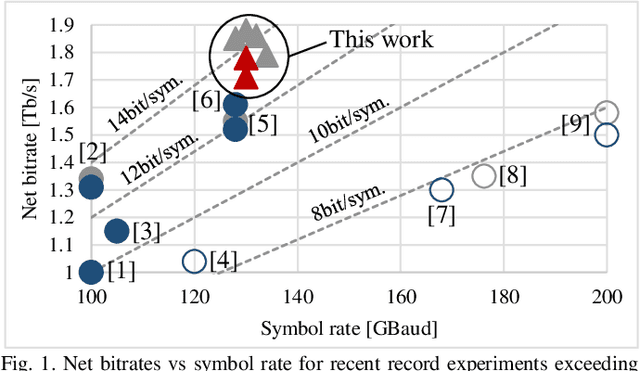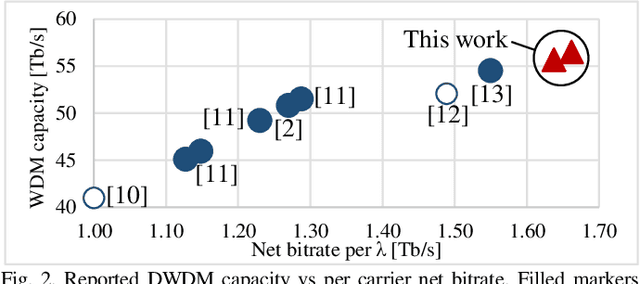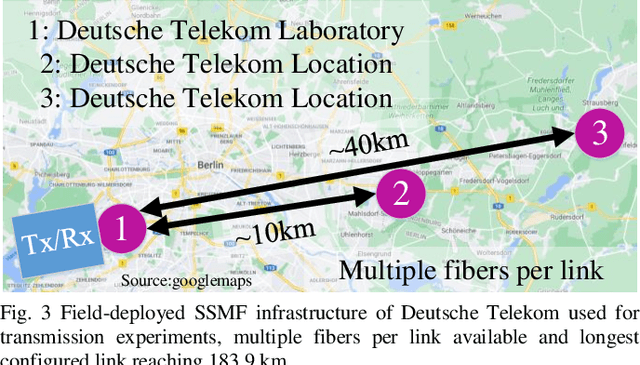Maximilian Schaedler
Soft-Demapping for Short Reach Optical Communication: A Comparison of Deep Neural Networks and Volterra Series
Jan 10, 2025Abstract:In optical fiber communication, optical and electrical components introduce nonlinearities, which require effective compensation to attain highest data rates. In particular, in short reach communication, components are the dominant source of nonlinearities. Volterra series are a popular countermeasure for receiver-side equalization of nonlinear component impairments and their memory effects. However, Volterra equalizer architectures are generally very complex. This article investigates soft deep neural network (DNN) architectures as an alternative for nonlinear equalization and soft-decision demapping. On coherent 92 GBd dual polarization 64QAM back-to-back measurements performance and complexity is experimentally evaluated. The proposed bit-wise soft DNN equalizer (SDNNE) is compared to a 5th order Volterra equalizer at a 15 % overhead forward error correction (FEC) limit. At equal performance, the computational complexity is reduced by 65 %. At equal complexity, the performance is improved by 0.35 dB gain in optical signal-to-noise-ratio (OSNR).
* 11 pages, 14 figures, journal
A Review of the Applications of Quantum Machine Learning in Optical Communication Systems
Sep 25, 2023Abstract:In the context of optical signal processing, quantum and quantum-inspired machine learning algorithms have massive potential for deployment. One of the applications is in error correction protocols for the received noisy signals. In some scenarios, non-linear and unknown errors can lead to noise that bypasses linear error correction protocols that optical receivers generally implement. In those cases, machine learning techniques are used to recover the transmitted signal from the received signal through various estimation procedures. Since quantum machine learning algorithms promise advantage over classical algorithms, we expect that optical signal processing can benefit from these advantages. In this review, we survey several proposed quantum and quantum-inspired machine learning algorithms and their applicability with current technology to optical signal processing.
Quantum and Quantum-Inspired Stereographic K Nearest-Neighbour Clustering
Aug 07, 2023Abstract:Nearest-neighbour clustering is a simple yet powerful machine learning algorithm that finds natural application in the decoding of signals in classical optical fibre communication systems. Quantum nearest-neighbour clustering promises a speed-up over the classical algorithms, but the current embedding of classical data introduces inaccuracies, insurmountable slowdowns, or undesired effects. This work proposes the generalised inverse stereographic projection into the Bloch sphere as an encoding for quantum distance estimation in k nearest-neighbour clustering, develops an analogous classical counterpart, and benchmarks its accuracy, runtime and convergence. Our proposed algorithm provides an improvement in both the accuracy and the convergence rate of the algorithm. We detail an experimental optic fibre setup as well, from which we collect 64-Quadrature Amplitude Modulation data. This is the dataset upon which the algorithms are benchmarked. Through experiments, we demonstrate the numerous benefits and practicality of using the `quantum-inspired' stereographic k nearest-neighbour for clustering real-world optical-fibre data. This work also proves that one can achieve a greater advantage by optimising the radius of the inverse stereographic projection.
Testing of Hybrid Quantum-Classical K-Means for Nonlinear Noise Mitigation
Aug 07, 2023Abstract:Nearest-neighbour clustering is a powerful set of heuristic algorithms that find natural application in the decoding of signals transmitted using the $M$-Quadrature Amplitude Modulation (M-QAM) protocol. Lloyd et al. proposed a quantum version of the algorithm that promised an exponential speed-up. We analyse the performance of this algorithm by simulating the use of a hybrid quantum-classical implementation of it upon 16-QAM and experimental 64-QAM data. We then benchmark the implementation against the classical k-means clustering algorithm. The choice of quantum encoding of the classical data plays a significant role in the performance, as it would for the hybrid quantum-classical implementation of any quantum machine learning algorithm. In this work, we use the popular angle embedding method for data embedding and the SWAP test for overlap estimation. The algorithm is emulated in software using Qiskit and tested on simulated and real-world experimental data. The discrepancy in accuracy from the perspective of the induced metric of the angle embedding method is discussed, and a thorough analysis regarding the angle embedding method in the context of distance estimation is provided. We detail an experimental optic fibre setup as well, from which we collect 64-QAM data. This is the dataset upon which the algorithms are benchmarked. Finally, some promising current and future directions for further research are discussed.
1.71 Tb/s Single-Channel and 56.51 Tb/s DWDM Transmission over 96.5 km Field-Deployed SSMF
Aug 04, 2021



Abstract:We report an industry leading optical dense wavelength division multiplexing (DWDM) field trial with line rates per channel exceeding 1.66 Tb/s using 130 GBaud dual-polarization probabilistic constellation shaping 256-ary quadrature amplitude modulation (DP-PCS256QAM) in a high capacity data center interconnect (DCI) scenario. This research trial was performed on 96.5 km of field-deployed standard single mode G.652 fiber infrastructure of Deutsche Telekom in Germany employing Erbium-doped fiber amplifier (EDFA)-only amplification. A total of 34 channels were transmitted with 150 GHz spacing for a total fiber capacity of 56.51 Tb/s and a spectral efficiency higher than 11bit/s/Hz. In the single-channel transmission scenario 1.71 Tb/s was achieved over the same link. In addition, we successfully demonstrate record net bitrates of 1.88 Tb/s in back-to-back (B2B) using 130 GBaud DP-PCS400QAM.
 Add to Chrome
Add to Chrome Add to Firefox
Add to Firefox Add to Edge
Add to Edge